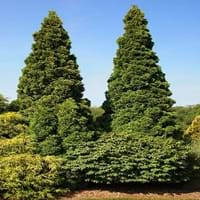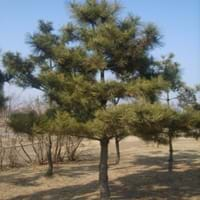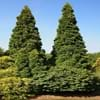Life Span
Perennial
Perennial
Type
Needled or Scaled Evergreen
Needled or Scaled Evergreen
Origin
Northeastern United States, Mid-Atlantic United States, Southeastern United States, North-Central United States, Central United States, Canada
Eastern Asia, Japan, Korea
Types
Not Available
Not Available
Habitat
Dry areas, Lake Sides, riparian zones, Slopes, Upland
sand dunes, Sandhills, Sandy areas
USDA Hardiness Zone
3-7
5-8
Sunset Zone
A2, A3, H1, H2, 1a, 1b, 2a, 2b, 3a, 3b, 4, 5, 6, 7, 8, 9, 15, 16, 17, 21, 22, 23, 24
3a, 3b, 4, 5, 6, 7, 8, 9, 10, 11, 12, 14, 15, 16, 17, 18, 19, 20, 21
Habit
Pyramidal
Pyramidal
Flower Color
Yellow, Yellow Brown
Non Flowering Plant
Flower Color Modifier
Bicolor
Bicolor
Fruit Color
Brownish Red, Red
Brown
Leaf Color in Spring
Green, Dark Green
Dark Green
Leaf Color in Summer
Green, Dark Green
Dark Green
Leaf Color in Fall
Green, Dark Green
Dark Green
Leaf Color in Winter
Green, Dark Green, Brown
Dark Green
Leaf Shape
Scale-like imbricate
Subulate
Plant Season
Spring, Summer, Fall, Winter
Spring, Summer, Fall, Winter
Sunlight
Full Sun, Partial Sun
Full Sun
Growth Rate
Medium
Medium
Type of Soil
Loam, Sand
Loam, Sand
The pH of Soil
Acidic, Neutral
Acidic, Neutral
Soil Drainage
Average
Average
Bloom Time
Spring
Fall, Summer, Winter
Tolerances
Drought
Drought
Where to Plant?
Ground
Ground
How to Plant?
Seedlings, Stem Cutting
Seedlings, Softwood cuttings, Stem Cutting, stem tip cuttings
Plant Maintenance
Medium
Medium
Watering Requirements
Drought Tolerant, Keep the ground moist but not water-logged, Requires regular watering
Do not water excessively, Do not water frequently, Needs less watering
In Summer
Lots of watering
Lots of watering
In Spring
Moderate
Moderate
In Winter
Average Water
Average Water
Soil pH
Acidic, Neutral
Acidic, Neutral
Soil Type
Loam, Sand
Loam, Sand
Soil Drainage Capacity
Average
Average
Sun Exposure
Full Sun, Partial Sun
Full Sun
Pruning
Remove damaged leaves, Remove dead branches, Remove dead leaves
Remove damaged leaves, Remove dead branches, Remove dead leaves
Fertilizers
All-Purpose Liquid Fertilizer
All-Purpose Liquid Fertilizer
Pests and Diseases
Citrus leaf miner, Drought, Edema, Gray mold
Red blotch
Plant Tolerance
Drought
Drought
Flower Petal Number
Single
Single
Fragrant Bark/Stem
Yes
No
Foliage Texture
Medium
Medium
Foliage Sheen
Glossy
Not Available
Attracts
Birds
Beetles, Nematodes, Sawfly, Scale Insects
Allergy
Anaphylaxis, Hives, Itchy eyes, Red eyes, Runny nose, Skin rash, sneezing, Watery eyes
Not Available
Aesthetic Uses
Showy Purposes
Bonsai, Not Used For Aesthetic Purpose
Beauty Benefits
Not Available
Not Available
Environmental Uses
Air purification
Air purification
Medicinal Uses
anti rheumatic, Astringent, Diuretic, Expectorant, Tonic
Antirheumatic
Part of Plant Used
Bark, extracted oil, Leaves, Twigs
Bark
Other Uses
Medicinal oil, Used as firewood, Used in herbal medicines, Used in Homeopathy
Herbicide, Used as a dye
Used As Indoor Plant
No
No
Used As Outdoor Plant
Yes
Yes
Garden Design
Feature Plant, Foundation, Hedges, Mixed Border, Screening, Wind Break
Feature Plant, Screening, Wind Break, Shade Trees, Topiary, Bonsai, Espalier
Botanical Name
THUJA occidentalis
PINUS thunbergii
Common Name
northern white cedar, swamp cedar, false white ceda
Japanese Black Pine
Black Pine
In Hindi
Thuja occidentalis
Japanese Black Pine
In German
Abendländischer Lebensbaum
Japanese Black Pine
In French
Thuya occidental
Japonais pin noir
In Spanish
Tuya del Canadá
Pino Negro Japonés
In Greek
Thuja occidentalis
Ιαπωνικά Μαύρη Πεύκη
In Portuguese
Thuja occidentalis
Japonês Black Pine
In Polish
Żywotnik_zachodni
Japoński sosna czarna
In Latin
Thuja occidentalis
White Pine Italica
Phylum
Tracheophyta
Tracheophyta
Class
Pinopsida
Pinopsida
Family
Cupressaceae
Pinaceae
Clade
Not Available
Not Available
Tribe
Not Available
Not Available
Subfamily
Not Available
Not Available
Importance of White Cedar and Japanese Black Pine
Want to have the most appropriate plant for your garden? You might want to know the importance of White Cedar and Japanese Black Pine. Basically, these two plants vary in many aspects. Compare White Cedar and Japanese Black Pine as they differ in many characteristics such as their life, care, benefits, facts, etc. Every gardener must at least have the slightest clue about the plants he wants to plant in his garden. Compare their benefits, which differ in many ways like facts and uses. The medicinal use of White Cedar is anti rheumatic, Astringent, Diuretic, Expectorant and Tonic whereas of Japanese Black Pine is Antirheumatic. White Cedar has beauty benefits as follows: Not Available while Japanese Black Pine has beauty benefits as follows: Not Available.
Compare Facts of White Cedar vs Japanese Black Pine
How to choose the best garden plant for your garden depending upon its facts? Here garden plant comparison will help you to solve this query. Compare the facts of White Cedar vs Japanese Black Pine and know which one to choose. As garden plants have benefits and other uses, allergy is also a major drawback of plants for some people. Allergic reactions of White Cedar are Anaphylaxis, Hives, Itchy eyes, Red eyes, Runny nose, Skin rash, sneezing and Watery eyes whereas of Japanese Black Pine have Not Available respectively. Having a fruit bearing plant in your garden can be a plus point of your garden. White Cedar has no showy fruits and Japanese Black Pine has showy fruits. Also White Cedar is not flowering and Japanese Black Pine is not flowering . You can compare White Cedar and Japanese Black Pine facts and facts of other plants too.





